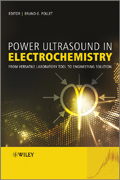
Power ultrasound in electrochemistry: from versatile laboratory tool to engineering solution
Pollet, Bruno
The use of power ultrasound to promote industrial electrochemical processes, or sonoelectrochemistry, was first discovered over 70 years ago, but recently there has been a revived interest in this field. Sonoelectrochemistry is a technology that is safe, cost-effective, environmentally friendly and energy efficient compared to other conventional methods. The book contains chapters on the following topics, contributed from leading researchers in academia and industry: Use of electrochemistry as a tool to investigate Cavitation Bubble Dynamics Sonoelectroanalysis Sonoelectrochemistry in environmental applications Organic Sonoelectrosynthesis Sonoelectrodeposition Influence of ultrasound on corrosion kinetics and its application to corrosion tests Sonoelectropolymerisation Sonoelectrochemical production of nanomaterials Sonochemistry and Sonoelectrochemistry in hydrogen and fuel cell technologies INDICE: Preface List of Contributors Acknowledgements Introduction to Electrochemistry? Bruno G. Pollet and Oliver J. Curnick 1.0 Introduction 2.0 Principles of Electrochemistry 3.0 Electron-Transfer Kinetics 4.0 Determination of Overpotentials 4.1 Decomposition Voltages 4.2 Discharge Potentials 5.0 Electroanalytical Techniques 5.1 Voltammetry 5.1.1 Cyclic Voltammetry 5.1.2 Voltammetry based on Forced Controlled Convection: Hydrodynamics Voltammetry 5.2 Amperometry 5.2.1 Chronocoulometry 5.2.2 Electrolysis 5.2.2.1 Parameters Important in Electrolysis 5.2.2.2 Electrolysis at Constant Potential 1. An Introduction to Sonoelectrochemistry Timothy J. Mason and Verónica Sáez Bernal 1.1 Introduction to Ultrasound and Sonochemistry 1.2 Applications of Power Ultrasound through Direct Vibrations 1.2.1 Welding 1.2.1.1 Machining (Drilling and Cutting) 1.2.1.2 Metal Forming 1.3 Applications of Power Ultrasound through Cavitation 1.3.1 Homogeneous Reactions 1.3.2 Heterogeneous Reactions involving a Solid/Liquid Interface 1.3.3 Heterogeneous Liquid/Liquid Reactions 1.4 Electrochemistry 1.5 Sonoelectrochemistry - The Application of Ultrasound in Electrochemistry 1.5.1 Ultrasonic Factors that Influence Sonoelectrochemistry 1.5.1.1 Acoustic Streaming 1.5.1.2 Turbulent Flow 1.5.1.3 Microjets 1.5.1.4 Emission of Shock Waves 1.5.1.5 Chemical Effects 1.6 Examples of the Effect of Ultrasound on Electrochemical Processes under Mass Transport Conditions 1.7 Experimental Methods for Sonoelectrochemistry 1.7.1 Cell Construction 1.7.2 Stability of the Electrodes under Sonication 1.7.3 Some Applications of Sonoelectrochemistry 1.7.3.1 Electro- and Electroless Deposition 1.7.3.2 Electroanalysis 1.7.3.3 Environmental Protection 1.7.3.4 Electrosynthesis 1.7.3.5 Nanomaterials 1.8 References 2. The Use of Electrochemistry as a Tool to Investigate Cavitation Bubble Dynamics Peter R. Birkin 2.1 Introduction 2.2 An Overview of Bubble Behaviour 2.3 Mass Transfer Effects of Cavitation 2.4 Isolating Single Mechanisms for Mass Transfer Enhancement 2.5 Electrochemistry next to a Tethered Permanent Gas Bubble 2.6 Mass Transfer from Forced Permanent Gas Bubble Oscillation 2.7 Mass Transfer Effects from Single Inertial Cavitation Bubbles 2.8 Investigating Non-Inertial Cavitation under an Ultrasonic Horn 2.9 Measuring individual Erosion Events from Inertial Cavitation 2.10 Conclusions 2.11 Acknowledgements 2.12 References 3. Sonoelectroanalysis: An Overview Jonathan P. Metters, Jaanus Kruusma and Craig E. Banks 3.1 Introduction 3.2 Analysis of Pesticides 3.3 QuantifyingNitrite 3.4 Biogeochemistry 3.5 Quantifying Metal in Life or Death Situations3.6 Analysis of Trace Metals in Clinical Samples 3.7 Biphasic Sonoelectroanalysis 3.8 Applying Ultrasound into the Field: The Sonotrode 3.9 Conclusions 3.10 References 4. Sonoelectrochemistry in Environmental Applications María Deseada Esclapez, Verónica Sáez Bernal, Pedro L. Bonete Ferrández and José González-García List of Symbols and Abbreviations 4.1
- ISBN: 978-0-470-97424-7
- Editorial: John Wiley & Sons
- Encuadernacion: Cartoné
- Páginas: 384
- Fecha Publicación: 24/02/2012
- Nº Volúmenes: 1
- Idioma: Inglés
